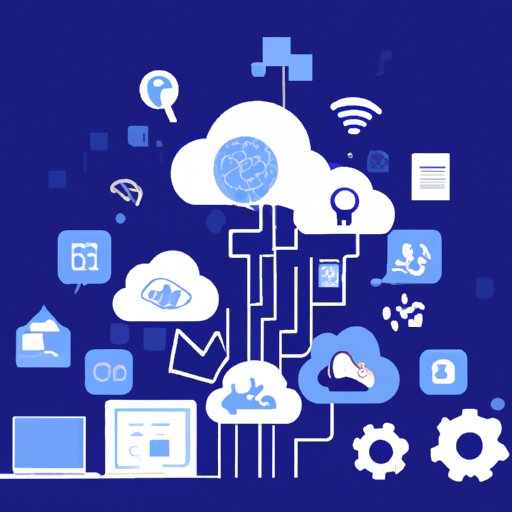Introduction
Productivity is a measure of how efficiently resources are used to produce goods or services. In today’s world, technology plays an important role in enhancing productivity. Technology has enabled businesses to increase output while reducing costs, allowing them to maximize profits and stay competitive in the global market. This article will explore how technology can be used to enhance productivity, including automating repetitive tasks, utilizing cloud-based software and services, applying artificial intelligence to data analysis, leveraging virtual collaboration tools, implementing project management systems, integrating mobile devices into the workflow, and utilizing automation for customer service.
Automating Repetitive Tasks
One of the most effective ways to boost productivity is to automate repetitive tasks. Automation reduces the amount of time spent on mundane activities, freeing up personnel for more value-added activities. Automation also eliminates human error, resulting in more accurate results. Additionally, automation can improve customer service by providing faster response times and increased accuracy.
There are many different types of automation tools available, ranging from basic scripts to advanced robotic process automation (RPA) platforms. Some examples include task schedulers, chatbots, and workflow automation tools. Each tool offers different benefits depending on the type of task being automated. For example, task schedulers are ideal for automating repetitive processes such as sending emails, while chatbots can be used to answer customer inquiries.
To set up automation, first identify the tasks that can be automated. Then, determine which automation tool is best suited for the task at hand. Finally, create the automation script or rule and configure it to meet the needs of the task. Once the automation is set up, it will run automatically, freeing up personnel for other tasks.
Utilizing Cloud-Based Software and Services
Cloud computing is a powerful tool for enhancing productivity. By storing data and applications on remote servers, businesses can access information from anywhere with an internet connection. This eliminates the need for physical storage media, making it easier to share data and collaborate with remote team members.
There are many different types of cloud-based software and services available. Examples include customer relationship management (CRM) systems, document sharing platforms, and online project management tools. Each of these tools offers different benefits, depending on the needs of the business. For example, CRM systems can help businesses manage customer relationships, while document sharing platforms make it easy to collaborate with remote team members.
To use cloud-based software and services, first identify the needs of the business. Then, select the appropriate software or service based on those needs. Finally, set up the software or service and configure it to meet the needs of the business. Once set up, the cloud-based software or service can be accessed from anywhere with an internet connection.
Applying Artificial Intelligence to Data Analysis
Artificial intelligence (AI) is another powerful tool for enhancing productivity. AI can help businesses analyze large amounts of data quickly and accurately, providing valuable insights that can be used to optimize processes and improve decision-making. This can result in increased efficiency and cost savings.
There are many different types of AI applications available. Examples include natural language processing (NLP) for understanding customer inquiries, machine learning for predicting customer behavior, and deep learning for recognizing patterns in data. Each application offers different benefits depending on the type of data being analyzed.
To implement AI, first identify the data that needs to be analyzed. Then, select the appropriate AI application based on the type of data. Finally, set up the AI application and configure it to meet the needs of the data. Once set up, the AI application can be used to analyze data quickly and accurately.
Leveraging Virtual Collaboration Tools
Virtual collaboration tools are essential for maximizing productivity when working with remote teams. These tools enable teams to work together from anywhere in the world, eliminating the need for physical meetings. This can result in increased efficiency and cost savings.
There are many different types of virtual collaboration tools available. Examples include video conferencing platforms, document sharing platforms, and online project management tools. Each tool offers different benefits depending on the type of collaboration needed. For example, video conferencing platforms can be used for real-time meetings, while document sharing platforms make it easy to collaborate with remote team members.
To use virtual collaboration tools, first identify the type of collaboration needed. Then, select the appropriate tool based on those needs. Finally, set up the tool and configure it to meet the needs of the collaboration. Once set up, the tool can be used to collaborate with remote team members from anywhere in the world.
Implementing Project Management Systems
Project management systems are essential for increasing productivity when managing complex projects. These systems provide an organized way to keep track of tasks, resources, deadlines, and budgets. This can result in increased efficiency and cost savings.
There are many different types of project management systems available. Examples include online project management tools, spreadsheet programs, and task scheduling software. Each system offers different benefits depending on the type of project being managed. For example, online project management tools can be used for tracking progress, while spreadsheet programs make it easy to manage budgets.
To set up a project management system, first identify the type of project that needs to be managed. Then, select the appropriate system based on those needs. Finally, set up the system and configure it to meet the needs of the project. Once set up, the system can be used to manage the project efficiently and effectively.

Integrating Mobile Devices into the Workflow
Mobile devices are a powerful tool for increasing productivity. By enabling employees to access information from anywhere, mobile devices eliminate the need for physical offices. This can result in increased efficiency and cost savings.
There are many different types of mobile devices available. Examples include smartphones, tablets, and laptops. Each device offers different benefits depending on the type of work being done. For example, smartphones are ideal for communication, while tablets can be used for accessing web-based applications.
To integrate mobile devices into the workflow, first identify the type of work that needs to be done. Then, select the appropriate device based on those needs. Finally, set up the device and configure it to meet the needs of the work. Once set up, the device can be used to access information from anywhere, eliminating the need for physical offices.

Utilizing Automation for Customer Service
Automation is also a powerful tool for improving customer service. Automation can reduce response times and improve accuracy, resulting in higher customer satisfaction. This can result in increased sales and cost savings.
There are many different types of automation tools available for customer service. Examples include chatbots, virtual agents, and knowledge base systems. Each tool offers different benefits depending on the type of customer service needed. For example, chatbots can be used for answering customer inquiries, while virtual agents can be used for providing personalized assistance.
To use automation for customer service, first identify the type of customer service needed. Then, select the appropriate automation tool based on those needs. Finally, set up the tool and configure it to meet the needs of the customer service. Once set up, the automation tool can be used to provide faster response times and improved accuracy.
Conclusion
Technology can be a powerful tool for enhancing productivity. By automating repetitive tasks, utilizing cloud-based software and services, applying artificial intelligence to data analysis, leveraging virtual collaboration tools, implementing project management systems, integrating mobile devices into the workflow, and utilizing automation for customer service, businesses can increase output while reducing costs. Ultimately, this can result in increased efficiency, cost savings, and higher profits.
In conclusion, technology can be a powerful tool for enhancing productivity. By leveraging automation, cloud computing, AI, virtual collaboration tools, project management systems, mobile devices, and automation for customer service, businesses can maximize their profits and remain competitive in the global market.
(Note: Is this article not meeting your expectations? Do you have knowledge or insights to share? Unlock new opportunities and expand your reach by joining our authors team. Click Registration to join us and share your expertise with our readers.)
